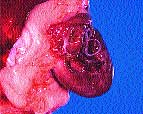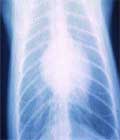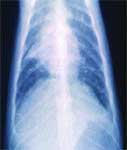Feline heartworm disease: Assessing the danger for owners
An owner depends on the veterinarian to assess the danger of any potential disease to his or her dog or cat. In some instances, these dangers are well known by the general public (rabies, distempter, FeLV), and owner's may request these "preventative measures".
An owner depends on the veterinarian to assess the danger of any potential disease to his or her dog or cat. In some instances, these dangers are well known by the general public (rabies, distempter, FeLV), and owner's may request these "preventative measures". In other diseases, the consequences of the disease are not as well defined or understood by owners, and the veterinarian serves the role as an advisor to the owners by increasing their awareness. Whether we like to consider it this way or not, the veterinarian serves in the capacity of a risk manager, much like selling insurance, and he or she has to lay out the gravity of the consequences of not using a preventative medication (insurance). Owners have to often visually "see" the dire consequences of not using a preventative (dehydrated cat with parvovirus for example) or be advised of these dangers. In the center of the awareness issue is being able to accurately determine the current disease status of a pet, as in "is it protected" or "is it currently infected".

Figure 1: three-Month disease cycle
The testing issue in feline heartworm disease is to many veterinarians the center of the problem in making owners appreciate the dangers of heartworm disease in cats. Because we have become so dependent on simple antigen testing for the presence of adult heartworms in dogs, the absence of simple unambiguous definitive heartworm testing in cats has led the practicing veterinarian to avoid discussions of the disease. Consider that in 2002, there were $351 million dollars of heartworm preventative medications sold in the United States, and feline heartworm prevention was only $14 million (4 percent) of this total. Yet, in almost every survey performed, feline heartworm disease is more common in the general cat population than feline leukemia virus infection in the United States. One obvious difference is that we currently have a definitive test for FeLV which although as a screening test has some nuances, practitioners feel secure in using the test and interpreting the results. If we consider feline health over the last 30 years, hyperthyroidism, FeLV, FIV and hypertrophic cardiomyopathy are "new" diseases which have become "main stream" concerns of cat owners mainly because diagnostic methods have been developed which give the veterinarian and owner some security in the ante mortem prediction of the "disease status." Many other feline diseases with real consequences are "off the radar" at this point simply because there is no easy diagnostic method.

Figure 2: Serology of Heartworm Infections
Three-month disease cycle
In feline heartworm disease, the diagnostics require more interpretation and the clinical signs are often demonstrated at a different time in the life cycle of the heartworm compared to the dog (Figure 1, p. 23). When the heartworm life cycle is described by parisitologists, veterinarians are often conditioned to consider heartworm disease as a six-month life cycle. However, it should be considered a three-month disease cycle. Just 90 to 100 days after a mosquito has infected a dog or cat with stage 3 larvae, immature L5 (adults) arrive in the right side of the heart. These immature heartworms are only 2 cm in length at 3-month-old immature worms. These small worms are carried out into the pulmonary circulation. Because of the pressure and direction of the flow, these small immature heartworms are deposited into primarily the distal left and right caudal pulmonary arteries. Thus, three months before there is any presence of antigen or microfilaria, heartworm disease is being induced (Figure 2, p. 23). In the dog, this timeframe is rarely associated with clinical disease although evidence can be demonstrated radiographically and histologically. However, in the cat, this three-month disease cycle (three to six months after infection) is often associated with marked increases in interstitial and bronchial disease on radiographs and the cat is much more likely than to the dog to have clinical signs of coughing and/or dyspnea with this early immature infection. A plausible explanation for the difference is that in dogs almost all of the immature L5 that arrive in the pulmonary arteries survive and develop into adults heartworms, resulting in minimal clinical signs during this three- to six-month period after infection. However, in the cat many of the immature L5 in the pulmonary arteries at three months die over the next several months, resulting in inflammation and peribronchial infiltration. (Photo 1) Some cats will develop this early infection, have immature L5 in their lungs, develop clinical disease, and yet never develop fully mature adult heartworms. Thus, the disease sequence is abbreviated in the cat, but there is a consequence of this infection, but compared to the dog, it is just over a shorter timeframe. Heartworm disease in the cat is not necessarily only associated with fully mature adult heartworms.

Photo 1: Although adult heartworms can develop in cats, disease can be induced months before the heartworm develops into a mature adult worm.
Determining heartworm status
Taking the three-month disease cycle into account, it is not surprising that cats with this early form of heartworm disease are all antigen negative. Given the fact that cats rarely have microfilaria, the standard diagnostic methods for the presence of circulating antigen or microfilaria do not apply to cats. Thus, a cat presented for coughing, dyspnea or sporadic vomiting unrelated to eating may have radiographic signs typical of a bronchial infiltrate with perhaps enlarged caudal pulmonary arteries, yet will be heartworm antigen negative. Because blood, tissue and fluids all have the same radiographic density, the enlargement in the caudal pulmonary artery is often not a consequence of enlargement of the pulmonary artery itself, but a combination of the pulmonary artery and all the inflammation around the distal pulmonary arteries associated with the death of immature L5 heartworms in these sites (Photo 2). Therefore, it is not surprising that in some cats, the apparent enlargement of the pulmonary arteries abate over time, even in the face of a continued adult infection. The spontaneous death of immature adult heartworms in cats causes an inflammatory pattern in the lungs of cats in a similar pattern to the death of heartworms in dogs after adulticidal therapy. The timeframe heartworm death is simply different in the cat (Photo 3, p. 25).
Antigen testing is detection of a glycoprotein of fully mature adult female heartworms in circulation. Therefore it is specific for D. immitis and will be negative in immature infections, male only infections, and dogs or cats with insufficient numbers of mature female heartworms to produce sufficient detectable antigen. Antibody testing however is influenced by the host response to the infection, and the antibody being evaluated varies from assay to assay as to the heartworm antigen source of the feline antibody being evaluated. Much like checking in on a football game, some assays pick the score up earlier in the game and others are more dependable later in the game. Despite the differences in the various antibody tests, most cats that are infected with heartworms become positive by about two-and-half to three months after the infection. A cat that is reported to be antibody positive has been successfully infected with heartworms, the L3 have molted to L4 and L5 and may or may not be currently present in the heart – but they have been infected. In a project currently being conducted at Auburn University, about 25 percent of random cats in the area that are over 1 year of age are antibody positive for feline heartworm disease. This infection rate suggests that many of these cats have had immature adult heartworms reach the lungs and induce pathology. Most of the research on feline heartworm disease have demonstrated that when experimentally infected with 25 to 50 infection larvae, the majority of cats will become antibody positive. However, mounting clinical evidence has demonstrated that some cats that have been infected and have adult heartworms demonstrated will be antibody negative, regardless of the assay method. A positive antibody result does represent a cat that has been successfully infected, however, a negative antibody result does not rule out feline heartworm disease infection. Antibody testing does not assure the heartworm status, either way, for the owner as to whether adult heartworms are currently present.

Photo 2: AVD radiograph of a cat experimentally infected with L3 demonstrates that four months after the infection there can be significant inflammatory lung disease. (Demonstrated in the right caudal lung lobe as increased opacity.)
Tentative diagnosis: Lose/lose proposition
After infection, cats have several different alternative paths for clinical disease. Some cats will have the immature heartworms continue to develop and, with or without intermittent clinical signs, have adult heartworms present. Other cats may have all the immature worms die over a period of several months with or without clinical signs. As noted in sedentary dogs, the majority of dogs currently diagnosed as heartworm positive have no clinical signs. In the cat, the suggestive clinical signs are coughing, dyspnea and vomiting unrelated to eating. However, many cats with adult heartworms will be asymptomatic for the majority of the time the cat is infected. Acute crisis and dyspnea can occur and are most often associated with the death of heartworms in cats.
In the examination room, discussions with owners about heartworm disease can be difficult. The tentative diagnosis of feline heartworm disease is usually in the presence of clinical and radiographic signs associated with heartworms and is usually supported by a positive antibody test (Photo 4, p. 26). Neither a negative antigen nor a negative antibody test rule out the possibility of heartworms. However, the tentative diagnosis places the veterinarian and owner in a lose/lose proposition. Only a positive antigen test or confirmation of the physical presence of the adult worm by echocardiography can definitively document the heartworm status. However, reliance on these diagnostics as being the only "confirmatory" results ignores the three-month disease cycle and this early severe inflammatory lung disease and resultant clinical signs in cats.

Photo 3: Although enlargement of the right caudal pulmonary artery has been associated with feline heartworm infections, this radio-graphic sign may disappear even in the presence of a continued heartworm infection. Much of the opacity is associated with inflammation of the adjacent tissues and a periarteritis.
A tentative diagnosis of feline heartworm disease is often initiated by an owner presenting a cat with typical "asthma" symptoms. The routine therapy of a combination of corticosteroids and bronchiodilators usually results an initial response. The addition of an antileuko-triene such as Singular (Merck) at a dose of 5 mg/cat once a day may also reduce the dose of corticosteroid needed to prevent clinical signs. However, the continued concern of the owner and veterinarian in this lose/lose proposition is the fact that if this cat does have adult heartworms, there is the real risk that an acute life-threatening crisis can develop. This can develop without any warning to the owner and the low doses of prednisolone typically used to control coughing will not prevent this acute crisis. The owner can become constantly fearful for the cat and the veterinarian can offer little assurance as to when and if this crisis will develop. Most cats have adult heartworms and intermittent disease and the adult heartworm die without a life threatening event. However, like selling insurance, prediction of consequence is all but impossible. In an attempt to blunt these fears, owners should be dispensed 50 mg prednisolone tablets to be given to their cat if they notice abnormal breathing patterns as they are rushed to their veterinarian. In instances where emergency therapy may be initiated by the veterinarian without current records on the cat, a vial of Solu-delta-Cortef (100 mg) is often given to the owner to place in their refrigerator with instructions to the admitting veterinarian for IV administration of the steroid combined with nasal oxygen therapy at the initial assessment.

Photo 4: A consequence of feline heartworm infection can be the peribronchial inflammation and coughing which is consistent with cats presented for "asthma."
In the inability of the veterinarian to clearly define the heartworm status of a cat to the owner, the simplicity of using a preventative has much merit. There are consequences to feline heartworm disease even if the diagnosis cannot be clearly and inexpensively defined for the owner. Much as the religious use of a vaccination program negates the need for testing of many viral infections, the use of heartworm preventative in cats avoids the morass associated with feline heartworm testing and therapy.
Dr. Dillon, professor of small animal surgery and medicine, received his DVM from Texas A&M University in 1973 Magma Cum Laude. He was an intern and clinical resident at Auburn University earning his MS in internal medicine in 1977 and MBA in 2001. He was board certified in the American College of Veterinary Internal Medicine (ACVIM) in 1978. Dr. Dillon was the first recipient and continues to hold the Jack O Rash Chair in Internal Medicine at Auburn University. He has been chair of the Section of Medicine for 20 years and was interim director of the Scott-Ritchey Research Center.

Suggested Reading
Dr. Dillon has been active in cardiopulmonary research, with emphasis on inflammatory lung diseases and congestive heart failure of dogs and cats. His accomplishments as a clinical scientist have been recognized through numerous awards. He is active in teaching internal medicine to veterinary professional students and graduate students, and receives referral cases at the Auburn University Teaching Hospital.